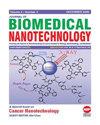Polydopamine Nanoparticles Activate Apelin/Apelin Receptor Signaling and Smad3 to Inhibit Tumor Cells in Lung Cancer
IF 2.9
4区 医学
Q1 Medicine
引用次数: 0
Abstract
Lung cancer incidence is increasing and different concentrations of polydopamine nanoparticles may exert different anticancer effects. Apelin/APJ plays a certain role in lung cancer. This study focuses on the mechanism of polydopamine nanoparticles in Apelin/APJ signaling pathway activation Smad3 on tumor cells in lung cancer rats. 40 rats were randomly assigned into blank group, model group, low-dose, medium-dose, and high-dose groups of polydopamine nanoparticles followed by analysis of tumor weight, Apelin, APJ, Smad3 gene expression, tumor cell viability, cell apoptosis, Apelin, APJ, and Smad3 level. Polydopamine nanoparticles were successfully prepared. The polydopamine nanoparticle groups significantly inhibited tumor weight, and the medium-dose group decreased the most. And the groups significantly inhibited the gene expression of Apelin and APJ, with more inhibition in medium-dose group, P < 0.05. The polydopamine nanoparticle groups significantly up-regulated Smad3, inhibited tumor cell viability, and promoted apoptosis with significant changes in medium-dose group. In addition, the groups inhibited the protein expression of Apelin and APJ, and up-regulated Smad3, with more increase of Smad3 in medium-dose group, P < 0.05. Polydopamine nanoparticles may block the combination of Apelin and APJ by inhibiting the activity of Apelin/APJ pathway, which leads to further activation of Smad3, therefore inhibiting proliferation and promoting apoptosis of lung cancer cells. This process is related to down-regulation of Apelin expression.多多巴胺纳米粒子激活杏仁蛋白/杏仁蛋白受体信号和 Smad3,抑制肺癌中的肿瘤细胞
肺癌的发病率越来越高,而不同浓度的多巴胺纳米粒子可能会产生不同的抗癌效果。Apelin/APJ在肺癌中起着一定的作用。本研究主要探讨多多巴胺纳米颗粒在肺癌大鼠体内激活肿瘤细胞 Smad3 的 Apelin/APJ 信号通路的机制。将40只大鼠随机分为空白组、模型组、多多巴胺纳米颗粒低剂量组、中剂量组和高剂量组,然后分析肿瘤重量、Apelin、APJ、Smad3基因表达、肿瘤细胞活力、细胞凋亡、Apelin、APJ和Smad3水平。多多巴胺纳米颗粒制备成功。多多巴胺纳米颗粒组对肿瘤重量有明显抑制作用,其中中剂量组抑制作用最强。各组对 Apelin 和 APJ 基因表达均有明显抑制作用,其中中剂量组抑制作用更强,P < 0.05。多巴胺纳米颗粒组明显上调 Smad3,抑制肿瘤细胞活力,促进细胞凋亡,中剂量组变化明显。此外,多多巴胺纳米颗粒组抑制了 Apelin 和 APJ 蛋白表达,上调了 Smad3,其中中剂量组 Smad3 上调幅度更大,P<0.05。多多巴胺纳米颗粒可能通过抑制 Apelin/APJ 通路的活性来阻断 Apelin 和 APJ 的结合,从而导致 Smad3 的进一步激活,从而抑制肺癌细胞的增殖并促进其凋亡。这一过程与 Apelin 的表达下调有关。
本文章由计算机程序翻译,如有差异,请以英文原文为准。
求助全文
约1分钟内获得全文
求助全文
来源期刊
CiteScore
4.30
自引率
17.20%
发文量
145
审稿时长
2.3 months
期刊介绍:
Information not localized

 求助内容:
求助内容: 应助结果提醒方式:
应助结果提醒方式:


